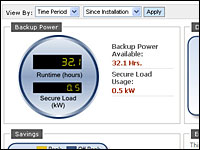 Smart Meter Saves Big Bucks For Pa. Family (Part 4)The fourth of a 10-part series Apr 28, 2009 - Elizabeth Shogren - npr.org
Tammy Yeakel had an unusual request for her 44th birthday present: a storm door. This stay-at-home mom from Allentown, Pa., got the idea from the Web site of her electric company, PPL Corp. When PPL put a smart meter on Yeakel's house, she didn't even notice at first. But when the company launched the Web site to help customers use information from the meters to save money, it brought out the passionate kilowatt-pincher lurking inside her. It's become her new obsession. "I love this site," says Yeakel as she clicks through bar charts of her family's energy use. "I called PPL and said, 'Did you design this for me?' Because I'm one of these people who love to know where my dollars [are] going and how can I save." President Obama wants to use stimulus money to help install 40 million smart meters nationwide to help Americans save electricity and money. Smart meters can track energy use daily, hourly, monthly and even instantaneously, and send that data to power companies. The advanced meters can save companies money, because they no longer need meter readers, and they can fix outages more efficiently. More Than Just Meters But PPL and other utilities that have begun installing the smart meters are finding that you need more than just the meters to help customers save power — there needs to be some kind of informational device, like a Web site, that will tell customers how much power they're using. For Yeakel, PPL's site helps her analyze her family's energy use and gives her lots of tips on ways to cut back. She got that storm door, she switched to compact fluorescent light bulbs, she wrapped her water heater and hot water pipes with insulation, and she keeps going back to the Web site for more ideas. "I went around with the foam insulation, and where I could see leaks outside from my basement, I squirt them," she says energetically. Her electric bills are about 20 percent lower than they used to be, and she's beating the competition. "This is one of my favorite things," Yeakel says, reading from the computer screen. "How does my home compare to similar homes in my area? And I'm always about $120 less than everybody. So that's kind of neat. That's like vacation." Monitoring Home Usage One recent afternoon, Tom Stathos from PPL is looking over Yeakel's shoulder as she clicks through the site. He notices that Yeakel's electricity use surges upward around 8 p.m. and asks her to explain what happens in her house at that time. "My husband comes home," she says. He turns on the television and lights, leaves doors open and starts cooking. "We're always behind him turning everything off," Yeakel says with a giggle, adding that even her 4-year-old twins pitch in. Stathos says that so far, Yeakel is unusual. Overall, PPL customers use 20 percent more electricity than they did 20 years ago. Many people don't realize how much charging iPods and cell phones adds to their electric bills. And some new products, like flat-screen plasma TVs, are electricity hogs, even when they're not being used. Yeakel says PPL's site has changed the way she thinks about energy. Making Smart Choices "For Christmas, we got one of those nice digital pictures. And everyone says 'Why don't you leave it on?' Cause it's an energy sucker, right? I learned that on the Web site." Stathos says that's a great example of how the site can help people save power. "It's not a matter of doing without — it's just a matter of making smart choices," he says. "The meter is the absolute direct connection with the customer. So this is definitely the start of a smart grid," Stathos says. With information from the smart meters, PPL is launching a new pricing program. It's offering two rates — one during times of peak energy use, and a cheaper, off-peak price. The company hopes this encourages customers to use less power when electricity is priciest. AndStathos says that's just a beginning. "I've got some brainstorms about the things I'd really like to do," he says. For instance, Stathos wants to give customers handheld devices — similar to TV remotes — that they could use to monitor their energy use and scale it back without leaving their armchairs. "I don't think that's far-fetched," he adds. Some electric companies say they hope to use smart technologies to reach into their customers' homes and actually turn thermostats up or down, change settings on water heaters or tell refrigerators not to defrost. In fact, in the future, when electric cars are popular, some utilities even hope to be able to store power on their customers' electric vehicles and put it back on the grid when they need it. |
Email this page to a friend
If you speak another language fluently and you liked this page, make
a contribution by translating
it! For additional translations check out FreeTranslation.com
(Voor vertaling van Engels tot Nederlands)
(For oversettelse fra Engelsk til Norsk)
(Для дополнительных
переводов проверяют
FreeTranslation.com )





